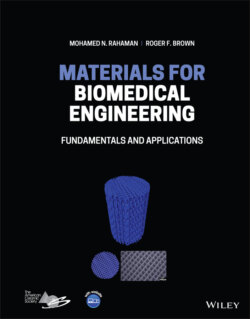Читать книгу Materials for Biomedical Engineering - Mohamed N. Rahaman - Страница 183
Profilometry
ОглавлениеNoncontact optical profilometry, based on the principle of interference between two light beams, is a widely used technique for characterizing the topography of materials. The reflected beams from two parallel plates placed normal to an incident beam interfere and result in the formation of fringes (lines) whose spacing is a function of the spacing of the two plates. If one of the plates is a reference plate and the other is a specimen surface whose roughness is to be measured, the fringe spacing can be related to the surface roughness (Figure 5.24). In white light interferometry, the incident beam is composed of all wavelengths in the visible spectrum, giving interference fringes of various colors in the spectrum. Profilometers based on white light interferometry have a lateral resolution of ~0.5–1.0 μm and a vertical resolution of ~1 nm. Consequently, this technique has a lower resolution than AFM.
Figure 5.24 Schematic illustrating the principle of optical interferometry.
Figure 5.25 shows a comparison of SEM, contact mode AFM and white light interferometry images of the same nominal material, Si3N4 in its as‐fabricated condition, a biomaterial used in spine repair. SEM shows a surface composed of elongated hexagonal grains, 0.2–2 μm in cross section, that protrude to various lengths, less than ~5 μm, in a random manner from the surface. Consequently, the roughness varies in scale from approximately a fraction of a micrometer to a few micrometers. Roughness parameters Ra and Rq obtained from AFM are 0.34 and 0.43 μm, respectively, values consistent with the SEM image. In comparison, Ra and Rq values obtained from white light interferometry are 0.64 and 0.83 μm, respectively. Whereas these values are almost twice those found from AFM, they are also consistent with the SEM image. One factor that could contribute to the difference between the AFM and interferometry values is that although the Si3N4 was fabricated using the same procedure, different regions of the material were imaged in the two techniques.
Figure 5.25 Topography of as‐fabricated silicon nitride obtained by (a) SEM, (b) AFM, and (c) optical profilometry.
Source: From Bock et al. (2017) / with permission of John Wiley & Sons.
